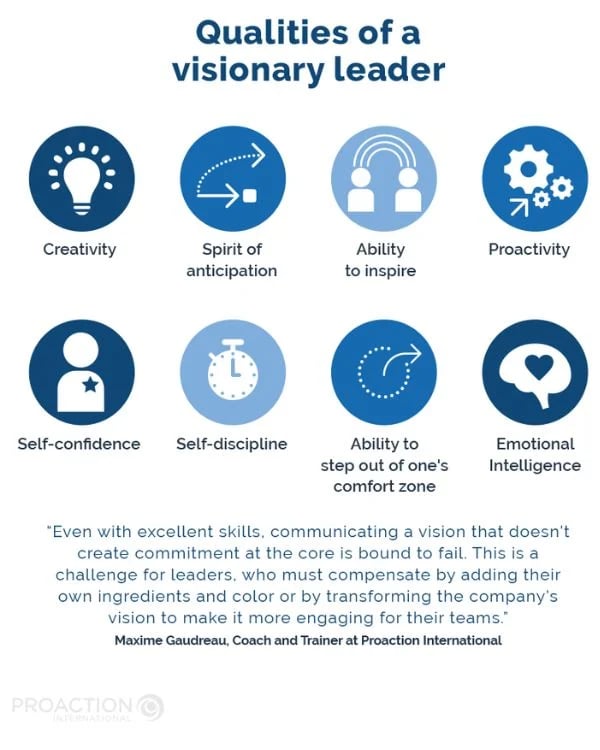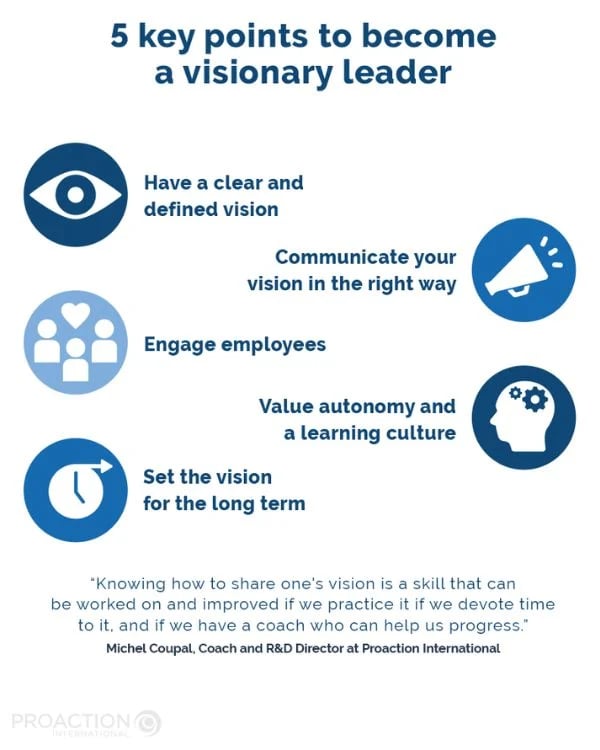Definition of visionary leadership
The word "visionary" refers to the ability to anticipate, to have a vision of the future. It is not about any magical power or supernatural visions but about a leader who can have a precise idea of the future and put in place the means to make this vision come true.
The idea of visionary leadership has been around for centuries, but American professor Burt Nanus first explained this theory in his book Visionary Leadership, published in 1992. In it, he states, among other things, that "Vision is not a luxury but a necessity; without it, workers would drift into confusion or, worse, act at cross-purposes."
Burt demonstrates how this vision is a key element of leadership and how leaders can use it to set a new direction for their companies. According to Burt, the vision has five characteristics:
-
It engages and energizes people;
-
It creates meaning in the lives of workers;
-
It sets a standard of excellence;
-
It builds bridges between the present and the future;
-
It transcends the status quo.
By inspiring, motivating, and engaging all employees, the visionary leader helps to raise the company's performance to a higher level and significantly increase its profitability.
Visionary leadership is becoming increasingly important. With the rapid development and democratization of powerful tools such as artificial intelligence, robotization, automation, and search tools, it is becoming easier and faster to get results. But without a clear vision that teams engage with, it becomes easier and easier to quickly run into a wall!
Visionary leadership is becoming increasingly important. With the rapid development and democratization of powerful tools such as artificial intelligence, robotization, automation, and search tools, it is becoming easier and faster to get results. But without a clear vision that teams engage with, it becomes easier and easier to quickly run into a wall!
Maxime Gautreau, Coach and Trainer at Proaction International
Some great visionary leaders of the 21st century
History has many visionary leaders. Among those who have marked the 21st century are Steve Jobs (Co-founder, President, and CEO of Apple Inc. ), Elon Musk (CEO and founder of Tesla), Jeff Bezos (CEO and founder of Amazon), Richard Branson (Founder of Virgin Group), Anna Wintour (Editor-in-Chief of the American edition of Vogue magazine), Michelle Obama (lawyer and author, former First Lady of the United States), Indira Gandhi (politician and Prime Minister of India from 1966 to 1977 and from 1980 until her assassination in 1984).
Sometimes adored, often hated, they are nonetheless great visionaries. Whether we like them or not, it is undeniable that their vision and their ability to go the distance have greatly contributed to changing our world and continue to shape it.
Tony Schwartz, a journalist at the New York Times, has discussed the subject of these visionary leaders who, as brilliant as they are, are far from unanimous in terms of personality and benevolence. Schwartz explains that these business leaders often behave badly because they can because they have enough money and power to override the social rules that apply to ordinary people, and because they can't stand the idea of losing control of their vision.
What are the limitations of visionary leadership?
Although it has many advantages, this type of leader also has its limits. Indeed, by wanting to go too far, too high, they may burn their wings. Some leaders only see the important actions and forget the small daily tasks that are important.
Others ask too much of their teams, without taking into account the individual needs of each one, thus creating a feeling of discouragement and even anger among the workers who become disengaged from the vision.
Finally, the emotional involvement and obsession of some leaders with their vision can end up biasing their decision-making.
Qualities of a visionary leader
Visionary leaders have excellent analytical skills and a wealth of creative thinking. They can see the big picture, and foresee, but also convey their vision, inspire and influence others. Here are the principal leadership skills that are needed:

Creativity
Always looking for new ideas and solutions to achieve the impossible, they constantly seek to innovate and surpass themselves to go further. Many visionary leaders even have a non-conformist side that allows them to see further and dare to do what has never been done before.
Spirit of anticipation
Since we are talking about the vision of the future, these leaders must not only be able to anticipate the future needs of their organization, but also to foresee possible obstacles and problems that may arise along the way, and therefore to face change. They will then be able to avoid them or find effective solutions while continuing to move forward toward their objectives.
Ability to inspire
More than just talking about their new vision, these charismatic leaders get their audience on board and manage to generate positive emotions. They know how to communicate their enthusiasm, their passion, and their mission to their employees, motivate them, make them want to reach the set objectives and realize that picture of the future.
Proactivity
Visionary leaders take charge by anticipating expectations and problems, putting action plans in place, focusing on solutions by imagining various possible scenarios, and acting on what can be controlled. They are not afraid to take risks or get started, even if things don't work out.
Self-confidence
They are optimistic and believe strongly in their vision. Regardless of the challenges they face, visionary leaders stay the course and do not doubt that they will achieve their goals.
Self-discipline
Visionary leaders must be able to manage themselves and have strong self-discipline so that they can set an example for others and be able to guide them. It is a question of being master of oneself, therefore of one's behavior, but also of one's time.
Ability to step out of one's comfort zone
Visionary leaders are not afraid to roll up their sleeves, to learn by doing things that are not part of what they normally do. They don't hesitate to go directly to the field to see how operations are going and are always looking for new ideas to evolve and move forward.
Emotional Intelligence
Emotional intelligence refers to a person's ability to discern, understand, control, and express his or her own emotions. It also consists in perceiving the emotions of others and dealing with them. An ability that not all visionary leaders have, but which is nevertheless very useful. The American psychologist Daniel Goleman has written a book on the subject. In it, he describes the 5 components of emotional intelligence (self-awareness, self-control, internal motivation, empathy, mastery of human relations) and explains how crucial its role is in professional success.
5 key points to become a visionary leader
Being a good leader is one thing, being a visionary leader is another. Here are five essential practices to integrate this transformational leadership into your organization:

1) Have a clear and defined vision
Vision is the essential ingredient of visionary leadership.
In his book "Being a Visionary Leader," author Michael Hyatt (founder and CEO of Michael Hyatt & Company, a leadership development firm) explains the importance of vision and how to use it to propel an organization into a better future.
Once you have that compelling vision, it's important to define it as clearly as possible. For this, the SMART method is particularly useful. It consists in defining Simple, Measurable, Acceptable, Realistic, and Temporal (defined in time) objectives.
For me, there are 2 elements that are particularly important in a visionary leader. First of all, it is about seeing, knowing, feeling and even sensing a vision. In addition to being consistent with the success of an organization, this vision must be engaging and meaningful to the rest of the team, otherwise success will almost certainly be diminished. Then there are the skills to communicate that vision explicitly, but also through our everyday actions, all of which contribute to reinforcing the vision's narrative.
Maxime Gautreau, Coach and Trainer at Proaction International
2) Communicate your vision in the right way
The best visionary leaders have very good communication skills and know how to correctly transmit their vision to their collaborators to better lead them. To do this:
Prioritize the use of the present tense rather than the future tense to talk about what needs to be done to make the action more concrete.
-
Use simple and clear vocabulary rather than complicated jargon to make yourself understood and to get people to buy into your idea.
-
Speak directly to others in your speeches, using "you," for example, to integrate employees into your vision.
-
Communicate in the most transparent way possible, with a kind language that inspires those who listen to you.
-
Take care of your narrative axis by ensuring that each employee clearly understands the objectives, direction the company is taking, values, and challenges (past, present, and future).
-
Stay open and listen to your employees. Give them room to express themselves and come up with new ideas.
Talking about vision calls for skills to generate emotions in the people to whom you share that vision. Yet, even though leaders may have a vision, it is often beyond their scope to talk about it in an inspiring way and even to use it to support decisions or conversations.
Michel Coupal, Coach and R&D Director at Proaction International
3) Engage employees
A good vision is a shared vision. You need to develop a sense of belonging among your employees, to unify all levels of your organization to form a whole walking towards the same goal, namely the realization of the vision. Indeed, it often happens that employees do not perceive the direct link between their work and the success of the company. Faced with this search for meaning, the visionary leader can use his or her ability to inspire by getting employees to buy into his or her idea by showing them that it is a joint effort and that this vision meets everyone's interests.
What drives your employees? What motivates them? Answering these types of questions will help you better engage them in your project. Not only do they need to be convinced that the vision is right and take ownership of it, but they also need to sustain their effort over time to achieve it.
I don't know if visionary leadership is so important. But I do know that it is important to give meaning to our lives, and that most corporate visions are inspiring, that they can be used to give meaning to managers and employees if shared by a leader who knows how.
Michel Coupal, Coach and R&D Director at Proaction International
4) Value autonomy and a learning culture
As a visionary leader, you must be able to delegate work and trust your employees. Allow them to learn through training and coaching so that they can develop themselves, but also so that they can take initiative to make strategic decisions that meet their objectives. Give them what they need to be independent and successful while providing a motivating and fulfilling work environment.
5) Set the vision for the long term
Vision is important, but it needs to be sustainably embedded in the minds of employees and the company culture. To do this, you must regularly remind them of the long-term goal to be reached. For example, you can organize weekly meetings for short-term objectives and quarterly meetings for medium and long-term objectives.
Establishing daily rituals can also help, such as conducting Gemba walks, active supervision rounds, visiting and interacting with field workers, etc.
Finally, organizing seminars and other large-scale events is also a good way to discuss your vision again, continue inspiring your employees, and feed their interest in it.
Being a visionary leader: an ambition accessible to all
Are you wondering if visionary leadership is reserved for a certain elite, only for the great C-suite of this world? Well, no, this type of leadership is accessible to everyone, regardless of hierarchical level, company size, or sector of activity. It is a skill that can be nurtured and cultivated, a muscle that needs to be trained. The key is not how big the vision is but how clear and willing you are to achieve it and share it.
Although the corporate vision usually comes from the top, the managers, the employees, and, therefore, all stakeholders’ buy-in put it into practice together on a smaller scale. In the same way, a conductor sets the pace, transmitting his vision of a musical work, but his musicians play and bring the melody to life. One cannot go without the other.
Thus, as a manager, you become the ambassador of this corporate vision to your team members. A key role is transmitting it and ensuring that each talent is moving in the same direction. Your proximity to employees, your managerial skills, and the fact that you are close to the operational realities make you a master asset of this vision. It is you and your collaborators who can make it tangible.
I strongly believe that we can all develop the essential skills to become better visionary leaders. Otherwise, I would not be involved in coaching and training!
Maxime Gautreau, Coach and Trainer at Proaction International
Here are some ideas on how you can help:
-
Translate the organization's vision so your team understands and incorporates it into their daily work.
-
Create your own vision by proposing new concepts and new processes and by making changes at the team level, as these will then be reflected at the highest levels of the company and its growth.
-
Stay tuned for opportunities to participate at your level in achieving the vision. Opportunities within the workplace, but also outside of it. Watch what is being done in other organizations, and stay open-minded.
-
Share your ideas with your team, as each member can then participate and contribute.
Conclusion
Being a visionary leader is a great asset to stand out and succeed. They act as a driving force, even a propeller. They unite each member of the organization by inspiring and guiding them toward achieving a common goal over the long term.
Whether he or she is an executive or a front-line manager, the visionary leader is an intrepid pioneer who participates in change and allows the company to innovate and attain high growth by daring and going further.










